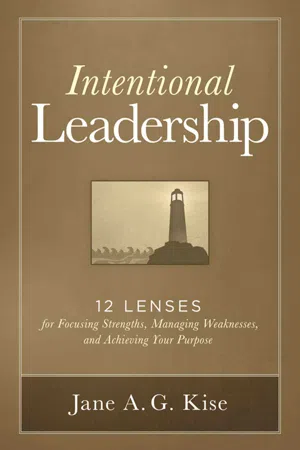![]()
CHAPTER 1
Learning From Intentional—and Unintentional—Leaders
I intend to be a good leader. That statement is true for you, right? After all, I've never coached anyone who intended to be the inspiration for a “How to Work for a Jerk” workshop or a situation comedy.
There's a vast difference, though, between having good intentions and being an intentional leader. The intentional leaders I work with plan how they will lead, not just what they will accomplish as leaders.
Phone calls launch the majority of my work as a management consultant. Calls from intentional leaders go something like this:
Hi, Jane. You worked with my team [or a colleague's team] at XYZ Company. I'm leading a new effort and want to start out on the right foot. Can you work with us so I can gain a clear picture of the ways my leadership style meshes with the strengths of my group and what areas or concerns I could easily overlook?
Intentional leaders have deep self-knowledge and recognize that their strengths come with blind spots. They know that every situation draws on their talents in ways that bring out inevitable limitations. They're intentional about identifying any potential problems as best they can.
Other calls follow this pattern:
Is this Jane? I doubt you can help me, but I got your name from________. The only thing the team I'm leading agrees on is that they hate me. They need to learn how to resolve conflict and work together.
These leaders, too, have good intentions, and great strengths and skills. The vast majority has a clear picture of their business goals and how to accomplish them. But they aren't intentional about how they are going to lead, nor have they reflected on the impact of their leadership style, the good and the not-so-good. They don't ask questions like:
• Who will I be leading?
• What will motivate these particular individuals to reach our business or organizational goals?
• What defines our environment?
• What emphases and actions on my part will have the greatest positive impact on my team's performance?
• Where might my style fall short of what is needed in this situation?
In The Truth About Leadership, James Kouzes and Barry Posner summarize their decades-long study of high-performing leaders, emphasizing that people are most influenced by their most immediate manager. They caution leaders to internalize, “It is not a question of ‘Will I make a difference?’ Rather, it's ‘What difference will I make?’”1 At every level, it is what leaders actually do each day that determines whether employees think highly of their workplace, view the work as important, believe that integrity on the job matters, and feel motivated to put forth their best effort.
What do those who report to you see you doing each day? Do they see you creating? Learning? Interacting? Listening? Observing? Have you thought about how your actions influence your team members' vision and their connection to your organization?
The first step toward intentional leadership is carefully defining your priorities to convey what you mean to convey—what you'll emphasize in a particular situation. Is accountability one of your core priorities? Do you believe that collaboration or empowerment is essential to success?
Once you've identified your leadership priorities, the second step in becoming an intentional leader is to align your leadership actions to convey the importance that you attach to those priorities. If accountability is one of your priorities, then convey the importance of being accountable by modeling it. If collaboration or expertise or mentoring is a priority, then collaborate, be open about adding to your expertise, and find a mentee.
Step 1: Identify Your Leadership Priorities
Following are forty leadership priorities. (They also appear in the appendix on page 151.) Your task is to choose your top ten. Think about a specific leadership position, either your current role or one to which you aspire. As you read each priority, ask yourself, “To be successful as a leader in this role, do I need to model this priority?” Cross out any priorities to which you answer, “No, modeling this isn't essential in this particular situation.” Then concentrate on the remaining priorities. Which are most essential? Remember, your list should include no more than ten.
1. Accountability: I establish realistic expectations and responsibility for outcomes, striving for clarity regarding what is and isn't under our control.
2. Achievement: I believe in setting worthy goals, planning for how to reach them, and then doing so.
3. Adaptability: I model being able to adjust to ever-changing circumstances, responding to the needs of the moment.
4. Appreciation: I want to create an atmosphere where people demonstrate respect for each other, regardless of expertise.
5. Autonomy: I foster teams in which each member can be effective when thinking and acting independently.
6. Balance: I want to model limits on work so that I and those with whom I work make time for family, health, leisure pursuits, nature, and relationships.
7. Challenge: I'm motivated by exciting problems or difficult, risk-filled tasks that enhance skills and prove competency.
8. Collaboration: I want to foster meaningful teamwork where people enjoy working together and keep everyone's best interests in mind.
9. Connecting: I believe that listening to understand the viewpoints, feelings, and aspirations of those I lead increases my effectiveness.
10. Creativity with the known: I value using sound judgment, proven routines, and known information for continuous improvement in practical matters.
11. Creativity with the new: I value using my imagination and inspirations to devise original ideas, theories, tools, methods, or plans that bring about change.
12. Depth: I want to be in charge of long-term, significant projects for which we pursue a major goal or develop important expertise.
13. Dependability: I want to be known as trustworthy and reliable, carrying out the charges I have been given.
14. Discovery: I explore choices, options, resources, learning opportunities, networks, friendships, theories, ideas, and so on; searching energizes me.
15. Efficiency: I want to organize our work environments, processes, tasks, and such, so that goals are met with little waste of time, talent, or materials.
16. Empathy: My style emphasizes stepping into the shoes of others and understanding their experiences, values, and points of view.
17. Empowering: I strive to enable others to learn to lead themselves and take the initiative in their work.
18. Enjoyment: I want to create a work environment that is inspiring, congenial, and playful, where people can find a touch of fun and humor.
19. Experience: I thrive when using our knowledge and past work, which are key to improving performance or to planning and implementing new but related work.
20. Expertise: I model respect of competency, honoring demonstrated skills, knowledge, work, and results.
21. Fair-mindedness: I believe in calmness and objectivity, using consistent standards so that my decisions and actions are fair, just, and effective.
22. Fulfillment: I want to concentrate my efforts on the dreams and endeavors that bring meaning and purpose to me and to those I lead.
23. Harmony: I work to keep conflict at bay so that people can concentrate on the tasks at hand.
24. Individuality: I value opportunities for solo efforts, making the most of each person's unique gifts, creativity, and inspirations.
25. Influence: I want to see my ideas, tools, or plans being used by others to create improvements, efficiencies, or significant change.
26. Legacy: I want to be involved in new ideas, paradigm shifts, or solutions to problems that others thought were difficult or even unsolvable.
27. Loyalty: I thrive when my skills, experience, and motivations are a long-term match to individuals, organizations, or causes.
28. Mentoring: One of my major responsibilities as a leader is guiding or supporting others in identifying their goals and developing their potential.
29. Networking: I am committed to making connections, sharing resources, and establishing relationships to enhance my team's effectiveness.
30. Openness: I seek and ponder contrary data, new perspectives, and other points of view before reaching conclusions.
31. Optimism: I want to inspire confidence in those I lead that our efforts will bring success.
32. Organization: I emphasize thinking through project or systems processes, needs, and expectations to create workable plans and practices.
33. Originality: I value tapping our imaginations, connecting ideas in unusual ways, and using artistic skills or other tools to find unique pathways.
34. Personal development: I am committed to continuous improvement of the skills and knowledge I and others need to reach our full potential.
35. Perseverance: I want to model and encourage others in sustaining momentum and having fortitude while making tangible progress.
36. Promoting: I work to advocate for needed resources and toot our horn externally.
37. Relationships: I invest time in building bonds with others for mutual support that can go beyond what might be required for the task at hand.
38. Results: Meeting or exceeding our stated goals is at the top of my priority list.
39. Variety: I thrive when my role involves a constant flow of new or novel activities, or many...

